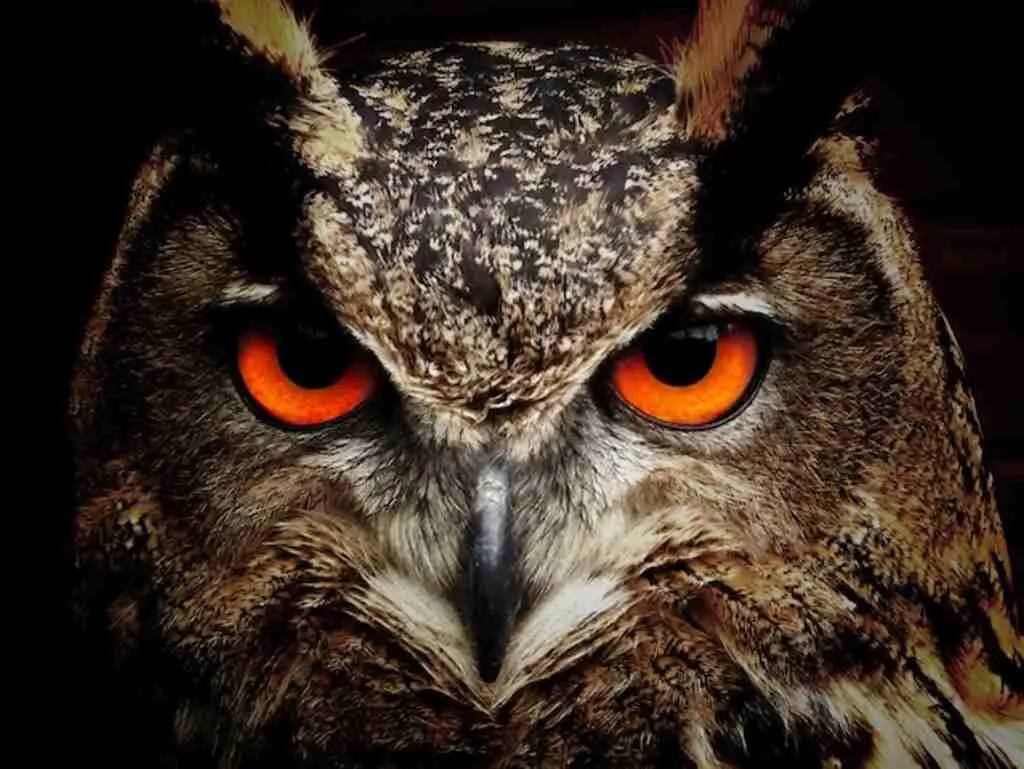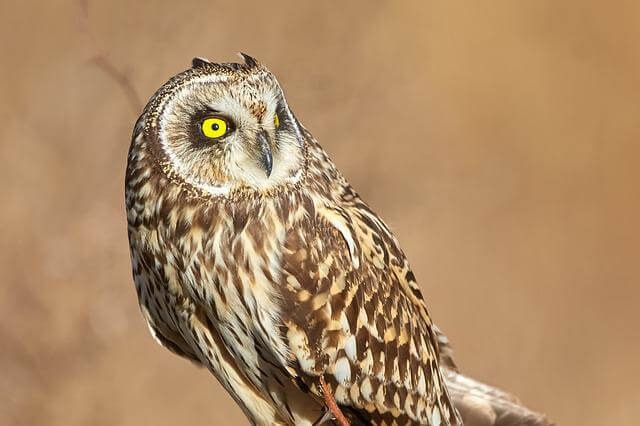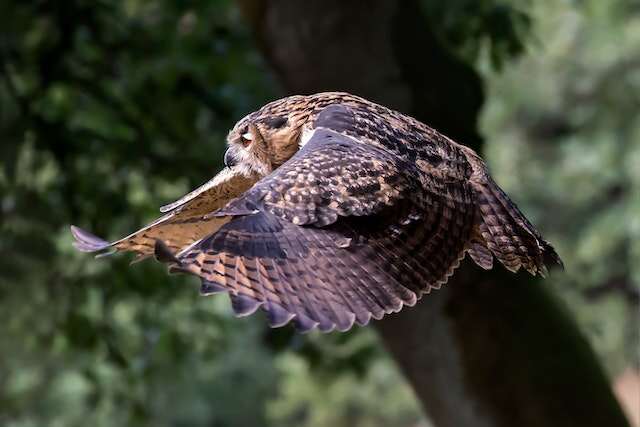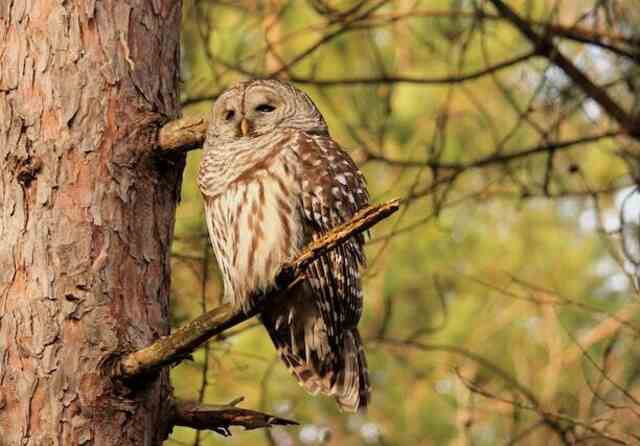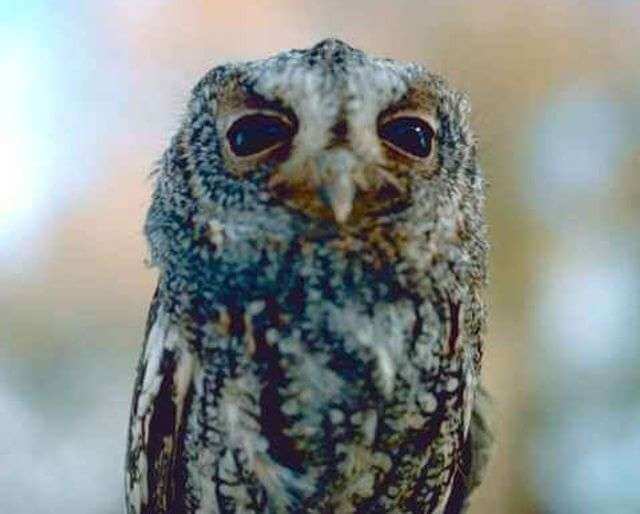Do owls have eyeballs, you ask? The answer is a resounding yes! But there’s more to these nocturnal creatures than just their mesmerizing eyes. From their silent flight to their mysterious hoots, owls have long captured our imagination. So, buckle up and join me on a journey into the intriguing world of these feathered friends.
Table of Contents
- 1 The Owl Eye Mystery Explained
- 2 Overview of Owl Anatomy
- 3 The Eyes of an Owl: A Closer Look
- 4 Do Owls Have Eyeballs?
- 5 Functioning of an Owl’s Eyes
- 6 FAQs For Do Owls Have Eyeballs?
- 6.1 Do owls really have eyes?
- 6.2 How many eyes do owls have?
- 6.3 Are owl eyes different from human eyes?
- 6.4 Can owls see in the dark?
- 6.5 Do owls have better eyesight than humans?
- 6.6 Do all owl species have the same eye structure?
- 6.7 Can owls move their eyes?
- 6.8 Why do owl eyes appear to glow in the dark?
- 6.9 Can owls close their eyes?
- 6.10 Are owl eyes affected by daylight savings time?
- 7 Conclusion
- 8 Author
The Owl Eye Mystery Explained
The idea that owls don’t have eyeballs comes from the fact that their eyes are so different from those of all other animals. Unlike human eyes or even those of most other birds, owl eyes are not spherical; rather, they’re elongated eye tubes that point forward in the skull.
This unique shape gives owls several advantages when it comes to hunting prey; for example, it allows them to see almost 360 degrees around them without having to move their heads.
The Importance of Understanding Owl Anatomy
To truly understand whether or not owls have eyeballs, it’s important to first understand their anatomy more broadly. Owls belong to a group of birds called raptors (or birds of prey), which includes eagles and hawks as well as falcons and kites.
Raptors are characterized by their sharp talons and hooked beaks, which they use to catch and kill prey. However, what really sets raptors apart is their visual acuity – in other words, how well they can see.
Owls are well known for their exceptional vision, especially when compared to other birds. To put this into perspective, the average human has a visual acuity of about 20/20, which means they can see objects clearly from 20 feet away.
However, an owl’s visual acuity is much better, at around 20/2, which means they can see objects clearly from 20 feet away that a human would need to be only two feet away from in order to see as clearly.
| Anatomical Feature | Humans | Owls |
|---|---|---|
| Eye size | Small | Large |
| Eye shape | Spherical | Tubular |
| Rods and cones | More cones, fewer rods | More rods, fewer cones |
| Tapetum lucidum | Absent | Present |
| Fovea | Well-developed | Absent |
| Field of view | 180 degrees | Up to 270 degrees |
| Depth perception | Good | Exceptional |
| Visual acuity | 20/20 | 20/2 |
| Range | 20 feet | 20 feet |
| Clarity | Clear | Exceptional |
As the table shows, owls have several unique anatomical features that contribute to their exceptional vision. Their large, tubular-shaped eyes have more rods than human eyes, which allows them to see in low light conditions and detect motion more easily.
They also have a tapetum lucidum, a reflective layer behind the retina, which helps to enhance their night vision. In addition, owls have a wider field of view and exceptional depth perception, which enables them to accurately judge distances and make precise movements when hunting.
On the other hand, humans have a well-developed fovea, a small area of the retina responsible for high-resolution central vision. This allows us to see fine details and colors more clearly than owls. However, our eyes are less suited to seeing in low light conditions or detecting motion.
Understanding these differences in owl and human eye anatomy can help us appreciate the unique adaptations that allow owls to be such successful predators in their environments.
What’s Inside: An Overview
In this article, we’ll delve deeper into how owls are able to see so well, focusing specifically on the structure and function of their eyes. We’ll also explore the controversy around whether or not they have eyeballs, and what makes their eyes so unique compared with other birds. We’ll look at the implications of this research for our understanding of animal vision more broadly.
Overview of Owl Anatomy
Owls are fascinating creatures with unique physical characteristics that set them apart from other birds. They have large heads, short necks, and powerful talons that make them excellent predators. Their bodies are covered in soft feathers that help them fly silently and stay warm during cold nights.
One of the most unique features of an owl is its eyes. These large, forward-facing eyes give them binocular vision, meaning they can focus on one point and see it clearly with both eyes.
Owls also have a third eyelid called a nictitating membrane that protects their eyes while still allowing them to see. Another interesting feature of an owl’s anatomy is its beak.
Unlike most birds, owls do not have a hooked beak for tearing flesh. Instead, their beaks are short and sharp to help them grip and kill prey.
How Owls See and Hunt Prey
Owls are known for their exceptional hunting abilities, which are largely due to their unique eyesight. Their forward-facing eyes give them excellent depth perception, while the ability to adjust focus quickly allows them to zero in on prey even in low-light conditions.
In addition to having impressive visual acuity, owls also rely heavily on their sense of hearing when hunting. They have asymmetrical ear openings located at different heights on each side of their head that allow them to pinpoint the location of sounds with incredible accuracy.
Owls hunt a variety of prey including rodents, insects, fish, and even other birds. Once they spot their target or hear movement nearby, they will fly silently toward it before pouncing with lightning-fast reflexes.
| How Owls See and Hunt Prey |
|---|
| Visual Abilities |
| – Exceptional hunting abilities due to unique eyesight |
| – Forward-facing eyes for excellent depth perception |
| – Quick adjustment of focus for low-light conditions |
| Auditory Abilities |
| – Reliance on sense of hearing when hunting |
| – Asymmetrical ear openings for pinpoint accuracy |
| Prey |
| – Rodents, insects, fish, and other birds |
| – Spot and fly silently towards target |
| – Pounce with lightning-fast reflexes |
Unique Features That Set Owls Apart from Other Birds
While all birds share certain physical traits such as wings and feathers, owls have several unique features that set them apart. One such feature is their ability to rotate their necks almost 270 degrees, allowing them to scan their surroundings without moving their bodies.
Owls also have a unique digestive system that enables them to swallow prey whole and regurgitate indigestible parts such as bones and fur in the form of pellets. These pellets provide valuable information for scientists studying owl behavior and diet.
Owls have a distinctive hooting call that varies between species and is used for communication and territory marking. Some species also use other vocalizations such as screeching, hissing, or bill snapping to ward off predators or attract mates.
Understanding the anatomy of an owl is essential for appreciating these magnificent birds’ unique abilities. The combination of exceptional eyesight, hearing ability, hunting techniques, and various physical features make them one of nature’s most fascinating creatures.
| Unique Features | Description |
|---|---|
| Silent Flight | Specialized feathers that reduce noise |
| Large Head and Eyes | Improved vision and depth perception |
| Powerful Talons | Grip and puncture prey |
| Asymmetrical Ears | Enhanced hearing ability |
The Eyes of an Owl: A Closer Look
Owls are known for their large, striking eyes, which are often the subject of much curiosity and speculation. The eyes of an owl are not only unique among birds but also among all animals in general. They have evolved to enable owls to hunt successfully at night when few other creatures can see.
A Detailed Description
The eyes of an owl are large and almost spherical in shape. They are placed at the front of their head, giving them binocular vision, which means they can focus both eyes on the same object simultaneously.
This gives them excellent depth perception, which is crucial for hunting prey. Their irises are immobile, which means they cannot move their eyes around like humans or many other animals can.
Instead, owls have developed a very flexible neck that allows them to turn their heads up to 270 degrees in either direction without moving their bodies. This compensates for the fixed position of their eyes and increases their field of view.
Comparison to Human Eyes and Other Bird Eyes
Owls’ eyes differ from those of humans and other birds in several ways. Their pupils are elongated instead of being round or oval like human pupils, allowing them to gather more light in low-light conditions. Additionally, compared to most birds’, owls’ eye sockets (orbits) face forward rather than sideways as they do in most birds.
This helps with depth perception since it provides a greater overlap between what each eye sees. Furthermore, unlike many daytime bird species that have cones (photoreceptor cells responsible for color vision), owls’ retinas contain mostly rods (photoreceptor cells responsible for detecting movement).
Owls don’t need color vision because they hunt mainly at night when there is little color contrast anyway. Instead, they rely on sharp vision and acute hearing to locate prey.
| Comparison to Human Eyes and Other Bird Eyes |
|---|
| Pupils |
| – Elongated pupils, gather more light in low light conditions |
| – Humans and other birds have round or oval pupils |
| Eye Sockets |
| – Owls’ eye sockets (orbits) face forward |
| – Most birds’ eye sockets face sideways |
| Depth Perception |
| – Greater overlap between what each eye sees for improved depth perception |
| – Humans and other birds have less overlap |
| Photoreceptor Cells |
| – Owls’ retinas contain mostly rods, responsible for detecting movement |
| – Most daytime bird species have cones for color vision |
| Color Vision |
| – Owls don’t need color vision for hunting at night |
| – Reliance on sharp vision and acute hearing instead |
| – Humans and many bird species have color vision for daytime activities |
How Positioning and Size Help Owls Hunt
Owls’ eyes are enormous compared to their body size. In fact, they are so big that they cannot move their eyes in their sockets.
Owls have to turn their whole head to look around, which can be quite disorienting for the uninitiated observer. However, the size of their eyes allows them to capture as much light as possible in low light conditions, providing excellent night vision.
Additionally, the positioning of owls’ eyes on the front of their faces gives them binocular vision and helps with depth perception. This means that they can accurately judge the distance between themselves and objects in their environment.
The combination of their large size, fixed position on the face, elongated pupils, and binocular vision gives owls incredible visual acuity that is essential for catching prey at night. An owl’s eyes are one of its most amazing features.
Their unique shape and position on the face give them unparalleled night vision and hunting abilities that are unequaled in other bird species or animals in general. It’s fascinating to learn about how evolution has adapted these creatures for life after dark!
Do Owls Have Eyeballs?
Answering the Main Question
Yes, owls do have eyeballs. However, due to their unique characteristics, it is understandable why some people may think otherwise. Unlike humans and most other animals, owl eyes are not spherical in shape.
Instead, their eyes are elongated tubes that are fixed in place within the bony sockets of their skull. This gives the impression that they lack traditional round eyeballs.
Why Some Believe Owls Have No Eyeballs
One reason why people might think that owls don’t have eyeballs is that they cannot move their eyes around like humans can. Instead of rotating their eyes in different directions to see things around them, owls rely on a flexible neck and specialized muscles to turn their heads up to 270 degrees to achieve a wide range of vision.
Additionally, owl eyes are covered with feathers except for a small opening called the “eye ring.” The feathers surrounding this opening create a distinctive facial disc that helps funnel sound into an owl’s ears. This can make it difficult to see the actual eye itself unless you look closely.
Discussion on What Makes Their Eyeballs Unique
While owls do have distinct eyeball shapes and limited mobility compared to other animals, there are some unique features that make them exceptional hunters. For one thing, owl eyes take up a significant amount of space within their skulls – up to 70% in some species – which allows for enhanced visual acuity.
Another feature is the presence of multiple layers within each eye’s retina that help them see well even in low light conditions or complete darkness. These layers magnify available light and allow them to adjust focus quickly between faraway objects and close-up prey.
Functioning of an Owl’s Eyes
Owl Eyes & Necks: Working in Tandem for a Wide Range of Vision
Owls are known for their incredible ability to rotate their heads in almost a complete circle. This is due to the unique structure of their neck bones, making it possible to turn their heads without harming themselves.
Combined with their elongated tube-like eyes, which provide greater depth perception than spherical eyes, owls can see prey from far away and monitor it as they approach. Once they get close enough, they can use their sharp talons and beaks to capture the prey.
How They See in Low Light Conditions, Including Night Vision
A big reason why owls are such effective hunters is due to their exceptional vision in low-light conditions. They have a higher density of rod cells in their retinas that allow them to detect even the slightest amounts of light during nighttime or low-light hours.
Additionally, special adaptations in their eyes allow them to magnify available light and adjust focus quickly between objects at different distances. This means that even when hunting at night or in dimly lit areas, owls can hone in on small movements from potential prey with great precision.
Their Ability to Adjust Focus Quickly
In addition to seeing well in low-light conditions and detecting distant prey, owl eyes also have an impressive ability to adjust focus quickly between near and faraway objects.
Unlike humans who need time for our eyes’ lenses to adjust focus, owl eyes are able to change shape quickly by squeezing muscles within the eye itself.
This allows them to maintain sharp vision regardless of distance and helps make them such effective predators.
FAQs For Do Owls Have Eyeballs?
Do owls really have eyes?
Yes, owls have eyes just like any other animal. In fact, their eyes are very important for their hunting and survival.
How many eyes do owls have?
Owls have two eyes, just like most other birds and mammals.
Are owl eyes different from human eyes?
Yes, owl eyes are different from human eyes in several ways. For example, owl eyes are much larger in proportion to their head size, and they have more rods (cells that detect light) than humans do.
Can owls see in the dark?
Yes, owls have very good night vision and can see in low light conditions. They also have the ability to adjust to different levels of light quickly, which helps them see in changing conditions.
Do owls have better eyesight than humans?
Yes, owls have much better eyesight than humans, especially when it comes to seeing in the dark. They also have a wider field of view and can see more clearly at long distances.
Do all owl species have the same eye structure?
No, different owl species have slightly different eye structures depending on their hunting and survival needs. For example, some species have eyes that are more forward-facing for better depth perception, while others have eyes that are more on the sides of their head for a wider field of view.
Can owls move their eyes?
Yes, owls have the ability to move their eyes to a much greater extent than humans can. They can rotate their eyes up to 270 degrees, which helps them see in different directions without moving their heads.
Why do owl eyes appear to glow in the dark?
Owl eyes appear to glow in the dark because they have a reflective layer of cells called the tapetum lucidum behind their retina. This layer reflects light back through their retina, which can make their eyes appear to glow in certain light conditions.
Can owls close their eyes?
Yes, owls can close their eyes, but they don’t have eyelids like humans do. Instead, they have a thin layer of skin called a nictitating membrane that helps protect and moisten their eyes.
Are owl eyes affected by daylight savings time?
No, owl eyes are not affected by daylight savings time. However, changes in the amount of daylight can affect their hunting and feeding behaviors, as well as their sleep patterns.
Conclusion
Summary of Key Points Discussed in the Article
Throughout this article, we’ve explored the unique characteristics of owl eyeballs and how they help these birds of prey hunt successfully. Despite their lack of mobility and unusual shape, owl eyes are highly specialized to detect prey from far away and in low-light conditions.
Implications for Further Research or Study
Future research could explore how variations in eye size and shape affect owl hunting success rates. Additionally, understanding the specific adaptations that allow them to see well in low-light conditions could have implications for developing new technologies for use in nighttime environments.
Final Thoughts on Why
Overall, the fascinating anatomy and function of owl eyes highlight the incredible adaptability of nature. From hunting at night to adjusting focus quickly, these birds have developed an arsenal of tools to help them survive and thrive in a wide range of environments.

